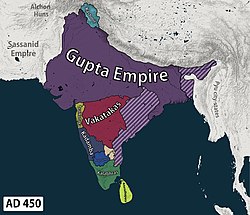The Traikutakas were a dynasty of Indian kings who ruled between 388 and 456. The name "Traikutakas" seems to be derived from the words for a three-peaked mountain ("Tri-kuta"). The Traikutakas are mentioned in Kalidasa's Raghuvamsa, in which they are located in the area of northern Konkan. The dominions of the Traikutakas further included Aparanta and northern Maharashtra.[2]
Traikutaka dynasty | |||||||||||
|---|---|---|---|---|---|---|---|---|---|---|---|
| c. 388 CE–c. 456 CE | |||||||||||
 Map of the territory of the Traikutakas (in yellow), along with their contemporaries, especially the Kadambas, the Vakatakas and the Gupta Empire. | |||||||||||
| Common languages | Sanskrit Prakrit | ||||||||||
| Religion | Hinduism | ||||||||||
| History | |||||||||||
• Established | c. 388 CE | ||||||||||
• Disestablished | c. 456 CE | ||||||||||
| |||||||||||
The coins of the Traikutaras are found extensively in southern Gujarat, and southern Maharashtra beyond the Ghats. Their design is very close to that of the Western Satraps, from which they probably inherited some territories, and traces of the obverse legend with Greek letters can still be seen.[3]
History edit
Some scholars theorize that the Traikutakas were a branch of the Abhiras,[4][5] and refer to them as the "Abhira-Traikutakas".[6] These scholars assume that the Traikutaka records were dated in the so-called Chedi-Kalachuri era, starting in 249 CE. However, later epigraphic discoveries and numismatic evidence contradicts this theory, and it is likely that the Traikutakas used the Shaka era.[7]
Indradutta, Dahrasena & Vyaghrasena were well known kings from this dynasty.[8] King Dahrasena expanded his realm, which soon bordered the Vakataka realm. This led to conflict and the Vakataka king Narendrasena, who with the help of his son & crown prince Prithivishena, probably defeated the Traikutikas, as later king Prithivishena's inscriptions refer to him twice rescuing the "sunken fortunes of his family".[9]
Traikutikas were known for their Vaishnava faith, who claimed to be Yadav of Haiheya branch.[10][11] and Dharasena performed Ashvamedha Yajna too.[4][12] During the reign of Maharaja Madhyamasena, the kingdom was invaded by the Vakataka king Harishena.[4][13] The dynasty ended around AD 550, when Vikramasena, the last known king died.[13] The Traikutakas were probably reduced to a vassal status under the Vishnukundins and had to accept Madhavavarman I's authority.[13]
Traikutaka rulers edit
The following Traikuta rulers are known from the coins and inscriptions of Gupta period-
- Maharaja Indradatta (AD 415-440,[13] only mentioned on the coins of his son) [14]
- Maharaja Dahrasena, son of Indradatta (A.D. 455),[4] he performed Ashwamedha[14]
- Maharaja Vyaghrasena, son of Dahrasena (A.D. 480)[4][14]
- Maharaja Madhyamasena
- Vikramasena
Further reading edit
- Rajgor, Dilip (1998). History of the Traikūṭakas: Based on Coins and Inscriptions. Harman Publishing House.
- MARILYN KATHLEEN EDWARDS LEESE (1983). THE TRAIKUTAKA DYNASTY AND KANHERI'S SECOND PHASE OF BUDDHIST CAVE EXCAVATION. Vol. I–II. University of MICHIGAN.
- Pandit, Suraj A. (2012). Age of Traikutakas Coins, Inscriptions and Art. Agam Kala Prakashan.
References edit
- ^ Rapson, E. J. (Edward James) (1908). Catalogue of the coins of the Andhra dynasty, the Western Ksatrapas, the Traikutaka dynasty, and the "Bodhi" dynasty. London : Printed by order of the Trustees. p. 198.
- ^ Rapson p.clxxxv.
- ^ Rapson, p.cixxiv.
- ^ a b c d e Radhakumud Mookerji (1997). The Gupta Empire (Paperback). Motilal Banarsidass. p. 38. ISBN 9788120804401.
the Traikutakas who were rulers of the Aparanta or Konkan and identified by some scholars with the dynasty of Abhira Isvarasena
- ^ Ramesh Chandra Majumdar (1968). The Age of imperial unity. Bharatiya Vidya Bhavan. p. 223. Retrieved 3 January 2011.
Although the Traikutakas, who flourished in the northern Konkan in the flfth century, may have been a branch of the Abhira tribe, Mayurasarman's inscription points to the separate existence of the Abhira and Traikutaka kingdoms in the fourth century.
- ^ S. V. Vishwanatha (1935). "The Abhira-Traikutaka Dynasty". Journal of the Asiatic Society of Bombay. Asiatic Society of Bombay. pp. 66–67. Retrieved 3 January 2011.
- ^ H.S. Thosar (1990). "The Abhiras in Indian History". Proceedings of the Indian History Congress. 51. Indian History Congress: 58–60. JSTOR 44148188.
- ^ Lionel D. Barnett (October 1994). Antiquities of India: An Account of the History and Culture of Ancient Hindustan. Asian Educational Services. pp. 49–50. ISBN 978-81-206-0530-5. Retrieved 3 January 2011.
- ^ Singh, Upinder (2016). A History of Ancient and Early Medieval India From the Stone Age to the 12th Century. Pearson India Education Services. p. 483. ISBN 9788131716779.
- ^ Vaidya, Chintaman Vinayak (1921). History of Mediæval Hindu India: Circa 600-800 A.D. Oriental Book Supplying Agency.
It is clear that the rule previous to that of the Gurjaras was that of the Traikutakas who claimed to be Haihayas by descent and whose capital Trikuta not yet well identified is mentioned even in the Rāmāyaṇa and in Kalidasa's Raghuvansha.
- ^ Gazetteer of the Bombay Presidency ..., Volume 1, Part 1 By Bombay (India : State), p. 58
- ^ Sailendra Nath Sen (1 January 1999). Ancient Indian History and Civilization. New Age International. pp. 426–. ISBN 978-81-224-1198-0. Retrieved 3 January 2011.
- ^ a b c d Vanina, Eugenia, ed. (1988). Indian History (Audiobook). Allied Publishers. p. 409. ISBN 9788184245684.
- ^ a b c Mookerji, Radhakumud (2007). The gupta empire (5th ed.). Delhi: Motilal Banarsidass. ISBN 9788120804401. Retrieved 19 July 2016.
- ^ Rapson, E. J. (Edward James) (1908). Catalogue of the coins of the Andhra dynasty, the Western Ksatrapas, the Traikutaka dynasty, and the "Bodhi" dynasty. London : Printed by order of the Trustees. p. 202.
References edit
- "A catalogue of the Indian coins in the British Museum. Andhras etc.." Rapson
![Silver coin of king Dahrasena. Obv: Bust of king. Rev: Chaitya and star.Brahmi inscription: "The glorious king Dahrasena, foremost follower of Vishnu, and son of king Indradatta".[1] of Traikutaka dynasty](http://upload.wikimedia.org/wikipedia/commons/thumb/3/3c/Dharasena%2C_Traikutaka_Dynasty.jpg/270px-Dharasena%2C_Traikutaka_Dynasty.jpg)